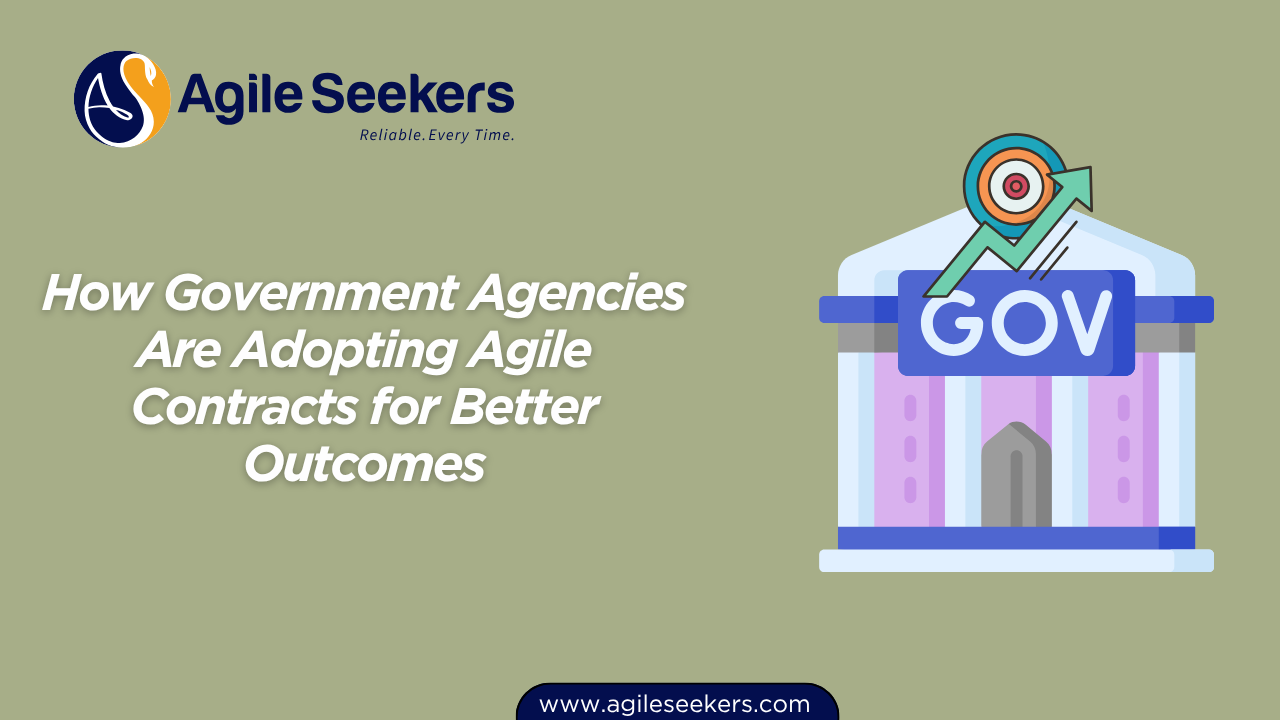How Government Agencies Are Adopting Agile Contracts for Better Outcomes

Government agencies across the globe are shifting away from rigid, scope-locked procurement practices and embracing Agile contracts to drive better value, flexibility, and collaboration. This transition isn't just a trend—it reflects a response to the real challenges governments face when delivering digital services in complex, uncertain environments.
Why Traditional Procurement Fails in Public Sector Projects
Government procurement has traditionally followed a waterfall contracting approach: fixed price, fixed scope, and fixed timelines. These models are rooted in the belief that requirements can be fully known upfront, and that vendors can deliver accordingly. The result? Frequent cost overruns, delays, misaligned solutions, and projects that often fail to meet public needs.
In contrast, Agile procurement acknowledges uncertainty and focuses on incremental value. This shift is particularly relevant in public sector digital transformation initiatives where citizen expectations are evolving rapidly.
What Are Agile Contracts in the Public Sector?
Agile contracts prioritize flexibility, learning, and collaboration. Instead of locking down all deliverables upfront, they allow for iterative development and continuous feedback. Governments using Agile contracts typically:
-
Procure capabilities instead of fixed solutions
-
Fund outcomes instead of outputs
-
Use short cycles for inspection and adaptation
-
Encourage co-creation between government and vendors
This approach aligns with frameworks like the SAFe® Managed-Investment Contract, which emphasizes shared goals, progressive funding, and adaptive scope management.
Real-World Government Adoption Examples
-
U.S. Digital Service (USDS) and 18F (GSA)
These two agencies are pioneers in U.S. federal Agile procurement. They've guided multiple agencies in adopting modular contracting, where work is broken into smaller, separately funded components. -
UK Government Digital Service (GDS)
GDS introduced guidelines promoting Agile-friendly procurement, including the Digital Marketplace, which allows departments to rapidly source Agile delivery partners. -
Australian Government’s Digital Transformation Agency (DTA)
The DTA has incorporated Agile principles into its sourcing processes, enabling better outcomes for projects across services like healthcare, welfare, and public safety.
Benefits of Agile Contracts in Government
| Benefit | Description |
|---|---|
| Early Value Delivery | Enables partial but usable solutions early, increasing stakeholder satisfaction. |
| Adaptability | Changes in citizen needs or policy direction can be addressed without renegotiating the entire contract. |
| Transparency | Short feedback loops allow clear visibility into progress and vendor performance. |
| Risk Management | Shared risk through iterative delivery instead of concentrating all risk on delayed milestones. |
| Innovation Enablement | Vendors are incentivized to propose better solutions as scope evolves with discoveries. |
How Government Agile Procurement Works in Practice
Agencies applying Agile contracts in public sector projects typically follow a few key practices:
-
Outcome-Based Statements of Work (SOWs)
Rather than detailing how something must be built, agencies define what outcomes need to be achieved. This provides vendors flexibility in execution. -
Rolling-Wave Planning
Scope and budget are planned incrementally, with periodic reviews to assess progress and adjust direction. -
Team-Based Contracts
Contracts may focus on assembling cross-functional Agile teams, rather than fixed deliverables, encouraging co-delivery with internal staff. -
Open Collaboration
Frequent check-ins, joint demos, and retrospectives ensure that both parties stay aligned on expectations.
Addressing Legal and Compliance Challenges
Transitioning to Agile doesn’t mean bypassing procurement regulations. It means interpreting them in a way that supports agility.
-
Legal teams must be involved early to understand how contract clauses can accommodate iterative work.
-
Compliance teams benefit from frequent delivery and transparency, which often exceed traditional auditability requirements.
-
Using time-boxed cycles with clearly defined acceptance criteria gives both legal and delivery stakeholders the confidence they need.
For professionals navigating this space, understanding Lean-Agile frameworks is crucial. Government agencies often look for trained professionals with certifications such as Leading SAFe Certification, which helps leaders structure Agile procurement models effectively.
Role of Agile Leaders and Coaches in Government Programs
Agile coaches, Scrum Masters, Product Owners, and Release Train Engineers play a central role in making Agile contracts work in public sector environments. They:
-
Facilitate communication across departments and vendors
-
Help define measurable outcomes
-
Lead incremental planning sessions
-
Maintain flow and transparency across government ARTs (Agile Release Trains)
For example, a certified SAFe Scrum Master ensures team-level agility, while a SAFe POPM ensures that product requirements reflect citizen needs and align with public goals.
As efforts scale, roles like the SAFe Release Train Engineer (RTE) and SAFe Advanced Scrum Master become critical to facilitate coordination across multiple teams and vendors working on large-scale systems.
Best Practices for Implementing Agile Contracts in Government
-
Start Small
Pilot Agile contracts with manageable scopes. Learn from feedback and build internal capability before scaling. -
Educate Stakeholders
Procurement officers, legal teams, delivery leaders, and finance departments all need to understand Agile values and delivery models. -
Use Cross-Functional Evaluation Panels
Involve business and technical experts in evaluating vendor proposals based on collaboration, responsiveness, and ability to deliver iteratively—not just cost. -
Measure Value, Not Just Cost or Schedule
Establish KPIs that reflect business or citizen outcomes. Track flow metrics, satisfaction scores, and release frequency.
Final Thoughts
Agile contracts offer public sector agencies a powerful alternative to rigid procurement methods that often fail in complex digital projects. By embracing iterative delivery, shared accountability, and continuous learning, government programs can deliver better results to the public.
Agencies ready to move in this direction need leaders equipped with Agile expertise. Programs like the Leading SAFe Certification and SAFe Scrum Master Certification prepare professionals to operate confidently in government Agile procurement environments.
For more insights, frameworks like the U.S. Digital Services Playbook and the UK Government Service Manual offer practical Agile guidance tailored to the public sector.
Also read - Agile Contracting Across the Enterprise
Also see - How Agile Contracts Support Lean Portfolio Management and the VMO




















